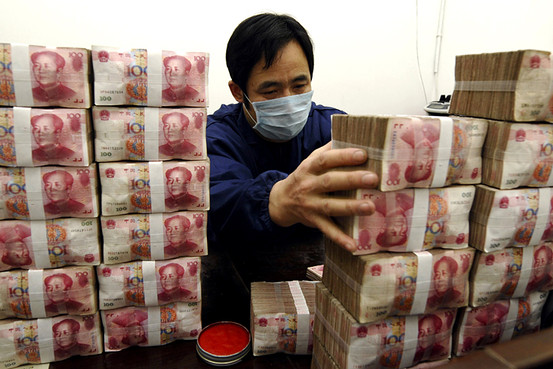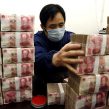
Beijing’s Record Revenue Haul Exacerbates Central-Local Tensions
Publication: China Brief Volume: 10 Issue: 14

While the world is still angst-ridden with the fragile recovery from the global financial crisis, there seems no end to auspicious tidings coming out of China. Riding on the back of robust exports–which grew by 33.2 percent the first half of the year–China’s economy is expected to expand by up to 10 percent in 2010. The Agricultural Bank of China could raise $22.1 billion in the world’s biggest initial public offering. Yet some apparently positive news might carry a big sting. Consider the State Administration of Taxation’s announcement last week that the central government is due to collect 8 trillion yuan ($1.18 trillion) of revenue this year, or four times that of 2003. This unwonted opulence would appear to insulate China from the scourge of snow-balling public debt, which is bedeviling Greece, Spain, Portugal, and to some extent, Japan and the United States (China News Service, June 30; New York Times, June 25: July 6).
Beijing’s fast-growing treasury, however, has even been described by the official media as a double-edged sword (Sina.com, June 28; China Economy Net, June 29). Firstly, this has provided conclusive evidence about the severe lack of “distributive justice”: that the bulk of wealth generated by 32 years of reform has gone to the central government and big enterprise groups, not to the majority of workers and peasants. Secondly, while the central coffers seem overflowing with cash, more local administrations than ever are on the brink of bankruptcy. The National Auditing Office (NAO) noted earlier this month that 18 provinces, 16 major cities and 36 counties had run up debts of 2.79 trillion yuan ($410.48 million). (The NAO did not disclose details about the fiscal health of other regions.)
Even more worrisome are runaway debts incurred by so-called urban development investment vehicles (UDIVs) or difang fazhan rongziping, which are firms either run or backed by local governments that take out bank loans typically backed by land assets. The risk is that in light of the country’s currently bubble-prone real estate market, the revenue from land sales, which are used to repay these bank loans, are bound to dry up. The state media has estimated that such debts range from 7 trillion yuan ($1.03 trillion) to upward of 10 trillion yuan ($1.47 trillion) (New York Times, March 15: June 24; Sina.com, June 30; Reuters, March 15).
Let us first examine the dearth of distributive and social justice, which is the root cause of the rash of labor and other unrest this year. Apparently anticipating the undercurrents of discontent, Premier Wen Jiabao pledged at this year’s National People’s Congress (NPC) in March that his cabinet will strive toward a more equitable share of the economic pie for all Chinese. “Let equality and justice shine brighter than the sun,” he said. “Let the people live with more dignity” (Xinhua News Agency, March 14; People’s Daily, March 15).
Yet, the lion’s share of national wealth has continued to flow into central coffers as well as large-scale enterprises. In the first five months of the year, revenues accruing to the central government grew by 30.8 percent and profits for big firms soared by 81.6 percent , while the income of workers and farmers went up by a mere 10 percent. In theory, this increase is well above inflation, which was 3.1 percent last May. Yet even the Chinese media admitted that the Consumer Price Index figure hardly reflected spiraling inflation, especially in the cities. For example, apartment rentals in urban centers jumped by nearly 20 percent in the first half of this year (People’s Daily, July 2; Xinhua News Agency, June 30).
A key reason behind the spate of labor incidents that first struck foreign-owned firms in the spring–and then spread all over China–is that a new generation of Chinese laborers is no longer willing to tolerate the unjust distribution of wealth. Salaries for workers as a percentage of GDP have fallen by 20 percent in the past 22 years. In his May Day address this year, President Hu Jintao vowed that Chinese workers “must be able to work with dignity” (Xinhua News Agency, May 1; China News Service, May 1). Under instructions from the Chinese Communist Party (CCP) leadership, almost all of China’s provinces and cities have raised the minimum wage for urban workers. Last week, nine provinces and cities, including Beijing, Shenzhen, Henan, Shaanxi, Anhui and Hainan, lifted their lowest salary scales from 15.8 percent to 31.7 percent. The minimum wage in prosperous cities and provinces such as Beijing, Guangzhou, Shanghai and Jiangsu has breached the 1,000 yuan mark ($147) (Changjiang Daily, July 3; Apple Daily [Hong Kong], July 2). While these figures seem impressive, they can hardly help workers cope with escalating living costs, especially in coastal cities. Take for instance Guangzhou’s minimum wage, which increased 4.4 times from 250 yuan ($36.78) in 1993 to 1,100 yuan ($161.84) earlier this year. During the same period, the average salary in the cosmopolitan city rose by 6 times. More significantly, while Guangzhou’s minimum wage was 50 percent of the average paycheck for workers in the early 2000s, the ratio has actually fallen to 30 percent (CCTV News, May 30; Sina.com, June 1).
Chinese scholars warn that Beijing needs to speedily address the “rich government versus poor citizenry” (guofu minqiong) dichotomy. According to Jia Kang, a senior researcher at the Ministry of Finance, while the Chinese government’s revenue is second only to that of the United States, the per capita income of Chinese citizens ranks behind that of more than 100 countries, including numerous Third World nations. Chinese Academy of Social Science economist Gao Peiyong warned that Beijing should immediately boost citizens’ share of the pie through means including lowering taxes for wage-earners and boosting cost-of-living subsidies to the jobless. “The government should significantly expand input in agriculture, education, technology, social welfare and health,” Gao told the Chinese press (Xinhua News Agency, July 1; Wen Wei Po [Hong Kong], June 30).
No less problematic is the contradiction between an increasingly well-heeled central government on the one hand, and impoverished local administrations on the other. Thanks to the success of the dual-tax system introduced by ex-premier Zhu Rongji in the mid-1990s, the central government’s share of national revenue has risen to more than 52 percent. This is despite the fact that the central treasury has continued to provide annual transfer payments to poor regions in central and western China. Such subsidies actually rose from 238.90 billion yuan ($35.15 billion) in 1994 to 2.86 trillion yuan ($420.77 billion) last year (Xinhua News Agency, July 1; China Youth Daily, July 2). Yet, the increasing marketization of the economy has made it relatively easy for resourceful local cadres to replenish their treasuries. Furthermore, the easiest way for municipal administrations to raise revenue is to sell land-use rights to real-estate developers. Local governments’ dependence on land sales–as well as taxation on properties–is deemed a key reason behind the Wen cabinet’s failure to tackle the real-estate bubble through 2009 and early 2010 (Xinhua News Agency, May 13; Beijing Youth Daily, January 9).
The imminent bursting of the real-estate bubble, however, has exposed the Achilles’ heel of financing grassroots governments. Nowhere is this more evident than in the irresponsible strategies of the estimated 4,000 UDIVs that have been set up since 2008. Aggressive investments initiated by regional cadres to re-energize local economies were initially portrayed by the media as well-timed efforts to complement the State Council’s 4 trillion yuan ($588 million) stimulus package unveiled in late 2008. A good number of UDIVs have underwritten gongyixing (“public interest”) projects in infrastructure and related sectors. It soon became clear, however, that the great majority of UDIVs was solely interested in speculative real-estate deals, many of which began to turn sour this past spring (China News Service, May 17; Shanghai Daily, June 29). According to a mid-year report by the NAO, debts sustained by seven provinces, 10 cities and 14 counties have exceeded their total sources of income; in the worst case, debts were 364.77 percent of revenue. Moreover, these 31 local administrations were forced to raise new loans to cover interests charged on old ones. Fears about the wholesale collapse of regional governments’ finances have in turn hamstrung Beijing’s efforts in rectifying the real-estate and other overheated sectors (Economic Reference News, June 30; Sina.com, June 30; Global Times, July 6).
It is a testimony to the State Council’s weak and lax control over the localities that it waited until last month to roll out a circular on “strengthening local governments’ management of investment vehicles.” The document praised a number of UDIVs for “strengthening infrastructure construction and for doing positive economic work in the face of the global financial crisis.” Yet the main thrust of the directive was that banks and financial institutions must exercise due caution when making loans to these firms. The State Council urged banks to “implement vetting procedures according to commercial principles, and to cautiously assess the borrowers’ ability and their [possible] sources for repayment.” Banks were told not to lend to borrowers with no adequate cash flow (People’s Daily, June 13; Xinhua News Agency, June 13). This belated instruction implies that many banks had extended credit lines to UDIVs without having done due diligence – and that this state of affairs was tolerated by both regional and central departments for a relatively long time.
What is behind Beijing’s failure to ensure that local governments observe a modicum of financial discipline? On the surface, the top party-and-state authorities seem to have ironclad control over the appointment, transfer or dismissal of regional officials. Since the days of ex-president Jiang Zemin, the CCP Department of Organization has used the “personnel card” to rein in recalcitrant and overweening “warlords.” Even before he became CCP General Secretary in late 2002, Hu, the head of the Communist Youth League Faction (CYLF), had begun systematically naming CYLF-affiliated cadres to senior slots in the localities. The party secretaries of about half of China’s 27 provinces and autonomous regions can be considered alumnae of the powerful League (Apple Daily [Hong Kong], June 11; Asia Times Online, May 1). Yet factionalism has proven to be no guarantee of either the administrative ability–or the fiscal prudence–of officials.
Regional cadres’ deficient fiscal discipline could in turn exacerbate the masses’ dissatisfaction with party-and-state apparatus. After all, a lot of the programs geared toward beefing up the social security net and raising the peasants’ standard of living, which Premier Wen has proclaimed with great fanfare, have to be implemented by grassroots government units. In addition, debt-ridden local administrations often dig into social-welfare and education funds to bankroll dubious investments in the real estate and stock markets–or to cover interests on bank loans. Should this state of affairs continue, social unrest will worsen as Beijing’s grip over regional warlords becomes more tenuous. The voluminous revenues accruing to central coffers will only give the CCP leadership a false sense of security–a dangerous premise going into the nation’s deepening contradictions.





